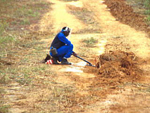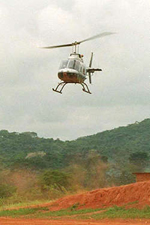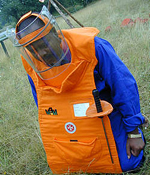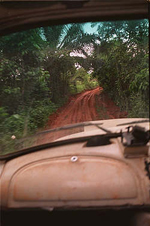Security

The loneliness of the deminer. His partner in the two-man team is always 25 metres away, watching him carefully.

MgM's strict safety procedures dictate that only after the evacuation of accident victim(s) to the nearest hospital has been arranged (by ambulance or helicopter), can demining work start.
Safety rules
Our elaborate safety rules called “Standard Operating Procedures(SOPs)”, are strict, documented and internationally recognized. They guarantee the highest degree of safety for our mine clearance personnel and for the population in the areas we clear.
A few examples of our guidelines:
- There are always two deminers working as a team at MgM. While one is covering the suspicious terrain with his detector and uncovering any signals, his team partner watches from a distance of at least 25 meters and corrects him if he deviates from our SOPs at any stage of the work. Every 30 minutes the team members reverse roles.
- At a pre-determined safety distance there is a fully equipped paramedic team and ambulance standing by for any medical emergency that may arise. Radio communication with active teams is constantly maintained.
Mine clearance can only start after MedEvac support to the nearest hospital has been arranged and is available on demand. If an accident occurs, we must be certain that an immediate evacuation of the victim/s to the hospital would be possible. If the traffic or road conditions do not allow this (and helicopters are not available) the operation must be stopped - in line with the safety procedures documented in our SOPs.
Despite the problems this may impose, MgM always abides by these self imposed restrictions. We do not endanger our staff more than necessary. For example, no MgM mine clearing operation will happen in an area that is surrounded by fighting because this would put our staff at unacceptable risk.
Until today only one accident has happened. In October 2088 one of our deminers showed a landmine he just found to another MgM worker after working hours - they didn't wear their safety wear. The landmine exploded and injured both of them in the face.

Modern safety wear made from Kevlar and other advanced materials can minimize the risk of injury from an anti-personnel mine explosion very close to the wearer.

The special tools used by our deminers.
The safety wear
The deminer (this is what mine clearing personnel are called) wears special safety gear when he is working. Apart from knee and calf protectors, it is mostly comprised of a Kevlar weave body armour that can stop the fragments from an exploding anti-personnel blast mine. Around the neck is a collar that stops fragments passing beneath the visor. Built into the body armour is a pocket used to store the scrap metal the deminer may find and a clip for his mine detection probe. The safety visor is made from thick, blast-resistant polycarbonate.
The tools
From a distance they look like simple garden tools, but they are all tailored to the special needs of mine clearance. The tools are made from selected steels, and high-density polyethylene with flexible armour shields. Because of their design, they bend rather than break or splinter dangerously in an explosion.
The communication gear
For the safety of the operation, reliable communications are highly important. Radios and satellite telephones are always on site and are manned by trained operators so that, in case of an emergency, they know exactly who to contact.

Behind every curve of a murky jungle road lurks danger incomparable to European situations. All MgM operations in the risky post-war African scenarios are therefore planned and executed under strict safety guidelines designed to protect our staff and the population we serve.
Training and Insurance
MgM sets high standards that result in highly professional operations. Continuous refresher training keeps MgM staff up-to-date at all levels. A standard for "normal" professions, this is a “must” for those employed in post -war mine clearance programs.
All of our staff, from driver and cook to dig-handler and deminer, must have more than a basic knowledge of using life saving communication tools (HF, Sat-phones, GPS, etc.).
All MgM staff have health and social insurance covering them against all kinds of mishap. While this is exceptional for internally operating demining organizations, MgM considers it essential that we show our respect and appreciation of the men who risk their lives daily in our name. In case of an emergency, they and their next of kin are comprehensively covered.

